|
Academic Leadership Development
(ALD) Program at College of Medicine, Jeddah;
King Saud bin Abdulaziz University for Health
Sciences
Saad
Abdulrahman Alghmdi (1)
Wesam Abuznadah (2)
Almoutaz Alkhier Ahmed (3)
(1) Dr. Saad Abdulrahman Alghamdi,
Consultant community medicine. SBCM, ABCM, MSc
in medical education.
National Guard Health Affairs, WR
Jeddah, Saudi Arabia
2) Dr.Wesam Abuznadah, Associate Dean, Academic
& Students Affair;
College of Medicine-Jeddah,
King Saud Bin Abdul-Aziz University for Health
Sciences
3) Dr.Almoutaz Alkhier Ahmed, Family medicine
Senior specialist and diabetologist
National Guard Specialized Polyclinics. National
Guard Health Affairs, WR
Jeddah, Saudi Arabia
Correspondence:
Dr. Saad Abdulrahman Alghamdi,
Consultant community medicine. SBCM, ABCM, MSc
in medical education.
National Guard Health Affairs, WR
Jeddah, Saudi Arabia
Email: drsaad32@gmail.com
|
Abstract
Introduction:
The new Medical College in Jeddah (COM-J)
- a branch of King Saud bin Abdulaziz
University for Health Sciences - is currently
confronting many challenges, accelerating
the need for effective academic leaders.
Unfortunately, little is known about how
the competency of academic leaders underpins
effective performance or how leaders might
be aided in acquiring competency. This
environment has driven authorities at
COM-J to be proactive in the establishment
of the Academic Leadership Development
(ALD) program for current and potential
future academic leaders.
Objectives: To assess the perception
of academic leaders on the importance
of capability, different approaches and
criterion for judging effective performance.
Methodology: A cross-sectional
online survey was conducted with 47 academic
leaders at COM-J. In addition to demographic
data, information on academic leaders'
perception of the importance of three
datasets (capabilities, approaches and
judging criteria) was collected using
a five-point Likert scale (1 - low to
5 - high). The project team and experts
in the field of leadership development
assessed the face validity of the survey
instrument. The reliability of the survey
instrument was calculated; Cronbach's
coefficient alpha was 0.97 (a high value).
Program Model: In response to the
need mentioned in the introduction, we
have adopted a model of academic leadership
development that has already been tested
in several large-scale studies of effective
leadership in higher education.
This model suggests an ongoing process
with 4 stages; Diagnosis, Development,
Implementation and Evaluation. Areas of
good practice are retained, and those
requiring further attention and new gaps
for development are re-addressed.
Results: The response rate was
100% (47), and the academic leaders perceived
that a combination of emotional intelligence
(both personal and interpersonal), cognitive
capabilities and a set of relevant skills
and knowledge are necessary for effective
performance as an academic leader at COM-J.
Conclusion:
We
produced a model for an ALD program at
COM-J with the following attributes:
• A set of capabilities and competencies
for effective leadership at COM-J.
•
A
set of quality checkpoints (criterion
for judging effective performance) at
COM-J.
•
An
online tool to enable future leaders to
complete the same survey and compare their
responses.
Key words: Education, leadership
|
Leadership development can be described as
the "longitudinal process of expanding
the capacities of individuals, groups, and organizations
to increase their effectiveness in leadership
roles and processes" (1).
Academic leadership is critical in higher education
because it influences the quality of student
learning (2). In Saudi Arabia, the Ministry
of Higher Education and leading Saudi universities
have recognized that leadership plays a significant
role in the success, effectiveness and quality
of higher education. Thus, the Ministry established
the Academic Leadership Center (ALC) in 2009
to give focus and emphasis to this critical
issue. Based on an initial plan, the ALC organized
numerous developmental activities to serve some
of the needs of Saudi higher education institutions
and administrators. These activities included
successful workshops for rectors, vice rectors,
academic deans and department chairs (3).
The new Medical College in Jeddah (COM-J) -
a branch of King Saud bin Abdulaziz University
for Health Sciences - is confronting many challenges,
which accelerates the need for effective academic
leaders. Unfortunately, little is known about
how the competency of academic leaders underpins
effective performance or how leaders might be
aided in acquiring competency. This environment
has driven authorities at COM-J to be proactive
in the establishment of the Academic Leadership
Development (ALD) program for current and potential
future academic leaders.
Middlehurst et al (4) question is there a difference
between leadership in higher education and other
organizations; they believe that there is no
difference (4).
Bryman (5) reviewed literature to determine
effective leadership styles in HE and found
that as there is no consistency in the literature
in using key terms it was difficult to form
a cumulative view (Bryman, 2009).
Although leadership is widely distributed across
universities, it is often subject to 'a somewhat
individualistic and management approach' (6).
The literature shows that very limited professional
development has been provided for academic leaders.
For example, only three percent of over 2000
academic leaders surveyed in the United States'
national studies from 1990 to 2000 had leadership
development programs at their universities (7).
However, in some developed countries, attempts
have been made to provide support for the academic
leaders. For example, in the United States,
the American Council on Education has been offering
a series of general national workshops for more
than 40 years. In England, the Leadership Foundation
for Higher Education was founded in 2004 by
the UK government to provide support and advice
on leadership and management for all UK University
and higher education colleges. In Australia,
in 2007, the federal government funded the LH
Martin Institute for Higher Education Leadership
and Management to meet the need for high quality
leadership in higher education (8).
In higher education, a competency-based approach
is an effective tool for leadership development
(9). Scott et al. (10) proposed a model for
academic leadership development (increasing
a leader's capability) that is shown in Figure
1. This model suggests that professional learning
for academic leaders will follow an action learning
cycle that involves an ongoing process to identify
the "gaps" in one's capabilities using
the leadership scales and dimensions and then
addresses these gaps using a mixture of self-managed
learning, practice-based learning, and appropriately
timed and linked formal leadership development.
As this process unfolds, the results can be
monitored using effectiveness indicators, and
the quality of what has emerged can be evaluated.
Areas of good practice are retained, and those
requiring further attention and new "gaps"
for development are re-addressed. In this manner,
the cycle continues. It is critical to view
the process not only as cyclical but also as
heading somewhere significant based on the validated
capability and focus scales that are identified
in the current study.
Figure 1: Model of Academic Leadership Development
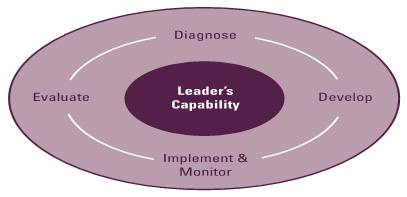
In response to the above-stated needs, we adopted
this model, which has already been tested in
several large-scale studies of effective leadership
in higher education led by Geoff Scott, Hamish
Coates and Michelle Anderson (10)(13). However,
as Bryman (5) reported that any leadership framework
that ignores context is ineffective, a competency
model created in one context cannot be assumed
to be generalizable to other contexts. It was
therefore important to contextualize this model
for COM-J.
This project proposal began in April 2013 and
the needs assessment part of it, began in August
2013 and the main fieldwork was concluded in November
2014.
A range of background reviews were conducted -
reviews of research literature and policy reports,
and of operating environments to provide a vital
contextual dimension to the project. The survey
instrument was adopted from a prior study of higher
education leaders led by Geoff Scott, Hamish Coates
and Michelle Anderson (10)(13). Initially, insights
from the background reviews were used to refine
the instrument. The instrument was further revised
and enhanced, and then deployed in a data collection.
2.1 Study Setting:
The study was performed at the College of Medicine
in the King Saud bin Abdulaziz University for
Health Sciences, in Jeddah, Saudi Arabia. These
classes were located within King Abdulaziz Medical
City, National Guard Health Affairs. Classes began
in the academic year (2010/2011 - 1431/1432) and
adopted problem-based learning curriculum. Currently,
there are 143 students and 128 (joint 106 &
22 full-time) faculty staff.
2.2 Study Population:
This study limited its definition of leaders to
people in academic roles, representing people
who are positioned as formal leaders at COM-J.
A total of 47 academic leaders - the entire population
- were included: one dean, three associate deans,
five chairmen, thirty block coordinators and co-coordinators,
and eight college council members.
2. 3 Study Design:
In this cross-sectional study, an online survey
was conducted for 47 academic leaders focusing
on the following:
1. Part 1: Academic leaders' relevant
demographic data
2. Part 2: Academic leaders' perception
of the relative importance of sets of leadership
capabilities to identify priority areas:
•
Personal capabilities
•
Interpersonal capabilities
•
Cognitive capabilities
•
Leadership competencies
3. Part 3: Academic leaders'
perception of the relative effectiveness of
different approaches to developing these capabilities
4. Part 4: Academic leaders' perception
of indicators that can be used to evaluate their
effectiveness
The respondents quantitatively rated the importance
of items using a five-point Likert scale (1
- low to 5 - high). The target leaders were
invited by email to participate in the survey
and were given an explanation of the survey's
purpose and significance. Follow- up emails
were sent at weekly intervals, and the researcher
undertook personal follow-up when necessary.
The survey was field-tested before distribution
and was designed for online completion in approximately
20 minutes using a Qualtrics online survey.
The responses were confidential and were not
linked to information on the sampling frame.
The data collection was completed by early November
2013.
2.4 Data Management and Analysis
The data analysis addressed each of the study's
objectives and included a summary of the means
and ordinal ranks across the academic roles.
2.5 Validation & reliability
This model has already been validated in large-scale
studies, as previously noted. The project team
and one expert assessed the validity of the
instrument. The reliability of the survey instrument
was calculated: Cronbach's coefficient alpha
was 0.97 (a high value) for all questions, and
each individual question varied from 0.8 to
0.93.
2.6 Ethical Considerations:
The nature of this project highlights many ethical
issues, these are:
1) Get an official approval from the Master
Program of medical education; Department of
Medical education ; college of medicine ; king
Saudi bin Abdulaziz University for health science
(KSAU - HS)
2) Get Approval from COM-J authority to conduct
this project.
3) Confidentiality - Because academic leaders
may be sharing very personal information. Participants
should not normally be named (unless their permission
has been explicitly sought, and this should
only be done where a name is essential for the
pursuit of the research in question).
4) Informed consent - part of the online survey.
This usually required that respondents agreeing
to participate, after being informed of potential
risks and benefits.
5) Promises and reciprocity - The issue here
is what the participants get in return for sharing
their time and insights.
The
main
results
will
be
divided
into
three
parts
including
the
leader's
capability
model,
approaches
for
academic
leadership
development
at
COM-J,
and
criterion
for
judging
effective
performance.
3.1
Leader's
Capability
Model
Leaders'
capability
consists
of
five
domains
as
seen
in
Figure
2.
Each
domain
was
given
operational
definitions
by
an
inventory
of
56
items.
Furthermore,
these
items
were
clustered
into
11
different
scales.
3.1.1
Domain
1:
Personal
Capability
Academic
leaders
particularly
emphasized
the
importance
of
the
following:
understanding
personal
strengths
and
limitations;
being
true
to
one's
personal
values
and
ethics;
having
energy,
passion
and
enthusiasm
for
learning
and
teaching;
wanting
to
achieve
the
best
outcome
possible;
and
remaining
calm
under
pressure
or
when
things
take
an
unexpected
turn.
Less
emphasis
was
given
to
facets
of
effective
leadership
that
involved
tolerating
ambiguity
and
uncertainty.
Figure
2:
Academic
Leadership
Capability
Domains

3.1.2
Domain
2:
Inter-Personal
Capability
Table
1
reports
the
importance
ratings
for
the
interpersonal
capabilities
items.
All
are
rated
highly
Table
1:
Interpersonal
capabilities
of
all
academic
leaders
at
College
of
Medicine,
Jeddah
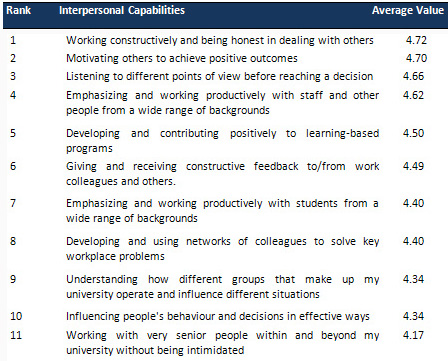
3.1.3
Domain
3:
Cognitive
capabilities
All
items
used
to
measure
the
cognitive
dimension
of
leadership
capability
were
rated
highly
by
the
COM-J
leaders
Table
2.
Table
2:
Cognitive
Capabilities
of
all
Academic
Leaders
at
College
of
Medicine,
Jeddah
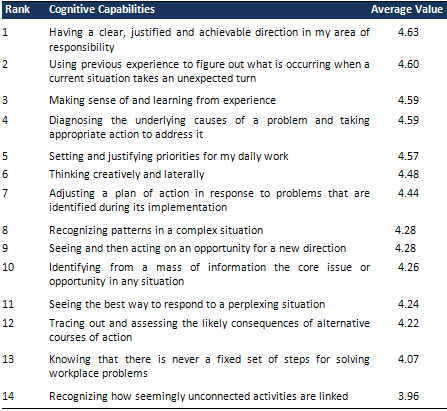
3.1.4
Domains
4
and
5:
Leadership
competencies
All
leadership
competencies
are
ranked
highly
(mean
above
4)
with
the
exception
of
competency
associated
with
understanding
of
industrial
relations
and
processes
as
they
apply
to
higher
education.
The
highest
levels
of
importance
were
attached
to
the
following:
Being
able
to
organize
work
and
manage
time
effectively;
the
ability
to
chair
meetings
effectively;
being
able
to
make
effective
presentations
for
a
range
of
different
groups;
the
comprehension
for
how
to
develop
an
effective
higher
education
learning
program;
and
being
able
to
help
staff
learn
how
to
deliver
necessary
changes
effectively.
3.1.5
All
the
Domain
Scales
The
academic
leaders
perceived
that
all
the
domains
of
the
leader's
capability
model
were
important
for
effective
leadership
at
COM-J.
The
average
scores
of
the
scales
within
the
main
domains
are
reported
in
Figure
3.
Figure
3:
Leadership
Capability
Importance
(average
scale
score)
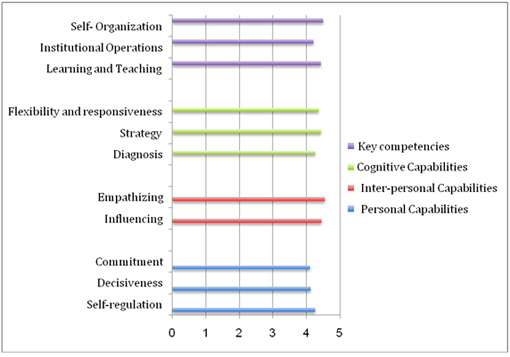
3.2
Approaches
for
academic
leadership
development
at
COM-J.
The
47
academic
leaders
were
asked
to
rate
the
effectiveness
of
each
of
the
learning
approaches
in
assisting
their
development
as
an
academic
leader
(1
[low]
to
5
[high]).
In
general,
the
leaders
at
COM-J
expressed
a
preference
for
attending
learning
and
teaching
conferences,
participating
in
higher
education
leadership
seminars,
learning
'on-the-job',
and
participating
in
leadership
development
programs
that
are
tailored
to
their
needs
more
than
completing
formal
leadership
programs
given
by
external
providers
or
even
by
the
university.
Table
3:
Indicators
of
Leadership
Effective
Performance
by
role
(items
ranks)
Only
the
first
5
ranks
are
reported
here
out
of
26
indicators.
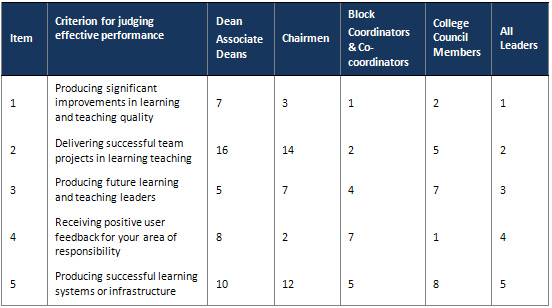
In
this
study,
respondents
were
asked
to
rate
the
importance
of
each
indicator
as
a
criterion
for
judging
effectiveness
in
their
role.
There
were
26
indicators
ranked
by
leader
roles.
The
results
of
the
survey
of
the
whole
group
(all
academic
leaders)
1)
Personal
Capability
of
all
academic
leaders
at
COM-J
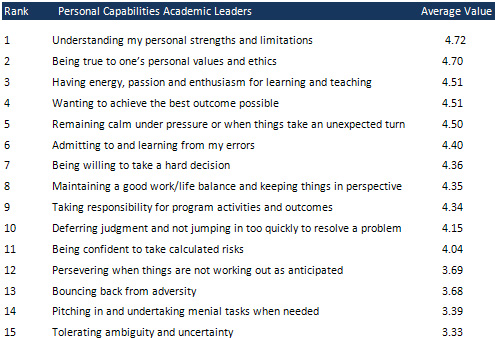
2)
Inter-personal
Capabilities
of
all
academic
leaders
at
COM-J
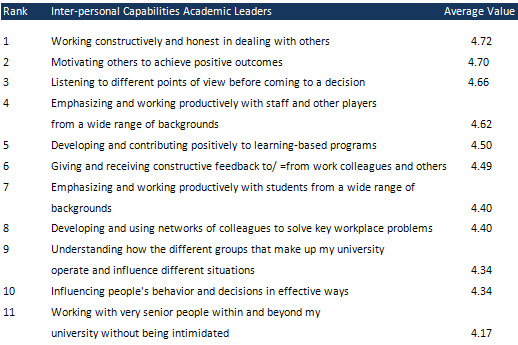
3)
Cognitive
Capabilities
of
all
academic
leaders
at
COM-J
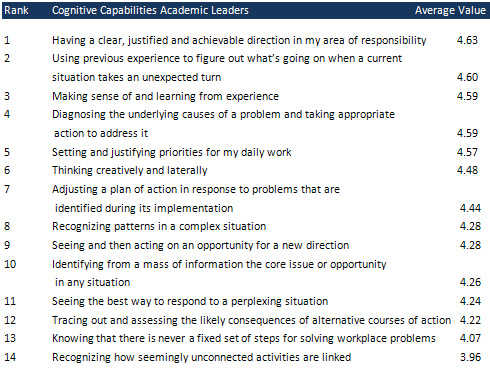
4)
Skills
and
Knowledge
of
all
academic
leaders
at
COM-J
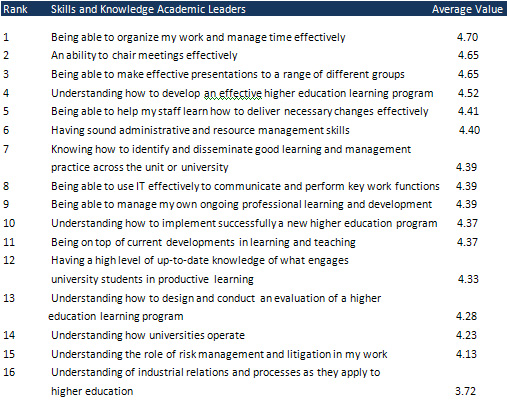
5)
Support
for
Leadership
(all
academic
leaders
at
COM-J)
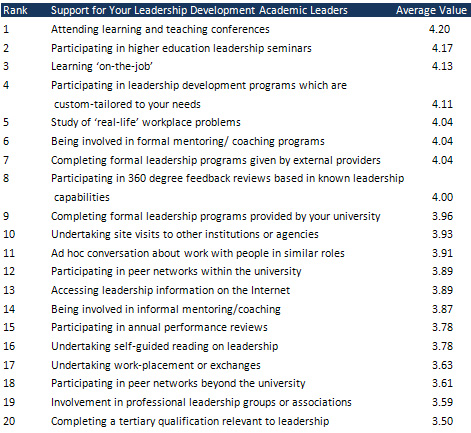
6)
Criterion
for
judging
effective
performance
of
academic
leaders
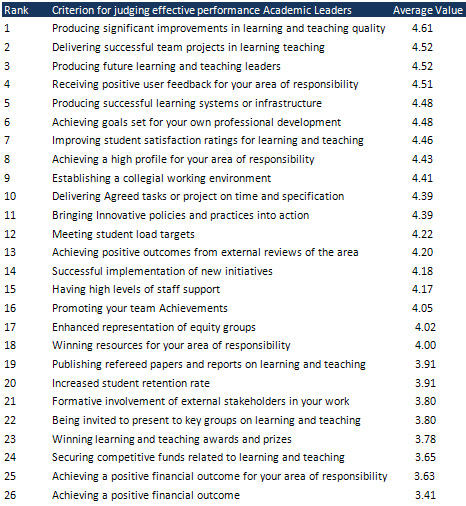
Establishing
a
competency-based
model
for
the
ALD
program
at
COM-J
will
follow
Kern's
six-step
approach:
problem
identification,
general
needs
assessment,
targeted
needs
assessment,
goals
and
objectives,
program
strategies,
implementation
and
evaluation.
This
study
constitutes
the
general
needs
assessment
step
of
the
project.
The
model
adopted
in
this
program
has
been
validated
in
large-scale
studies
not
only
in
Australia
but
also
in
Canada,
the
United
Kingdom
and
South
Africa,
where
international
review
workshops
were
conducted.
The
face
validity
and
reliability
were
assessed
and
calculated,
and
high
levels
were
found.
Leaders
must
be
able
to
manage
their
own
emotional
reactions,
and
this
ability
reflects
their
personal
capability.
It
is
also
important
to
have
a
high
level
of
interpersonal
capability
to
better
understand
what
is
occurring
and
to
determine
what
might
work
best
to
resolve
the
situation.
Both
personal
and
interpersonal
capabilities
have
been
extensively
researched
during
the
past
decade
by
researchers
such
as
Goleman
(11)
and
are
often
referred
to
as
a
leader's
"emotional
intelligence."
The
results
of
this
study
showed
a
strong
perception
of
the
importance
of
different
capabilities
for
effective
performance
for
all
academic
leaders
at
COM-J.
This
outcome
provides
an
important
form
of
contextualization
of
the
model
for
COM-J.
Effective
leadership
does
not
merely
involve
capability.
Leading
organizations
such
as
COM-J
also
require
both
generic
and
specific
knowledge
and
skills
-
the
bottom
circles
in
Figure
2.
These
areas
of
competency
provide
support
for
diagnosing
different
situations
and
are
also
a
source
for
shaping
and
delivering
the
appropriate
response.
Therefore,
all
five
domains
must
function
in
an
integrated
and
productive
manner
over
time.
Thus,
a
weakness
in
one
area
affects
the
operation
of
other
areas.
The
contribution
of
this
study
is
to
help
academic
leaders
to
develop
skills
that
are
important
for
the
effectiveness
of
academic
leadership.
Evidence
from
the
47
leaders
who
participated
in
this
study
affirms
that
effective
leadership
involves
both
individual
talent
and
a
situated
capacity
for
implementation.
Clearly,
professional
learning
is
not
essential
for
leadership
-
many
leaders
have
little
formal
training
in
leadership
prior
to
assuming
their
roles,
although
they
perform
well.
However,
leadership
training
is
a
helpful
and
undoubtedly
valuable
means
of
ensuring
high-quality
leadership.
Unless
academic
leadership
development
programs
are
implemented
properly
with
the
appropriate
approaches,
they
will
fail.
Therefore,
to
ensure
that
our
ALD
program
will
utilize
the
appropriate
approaches
for
implementation,
the
47
academic
leaders
completing
the
online
survey
were
asked
to
rate
the
effectiveness
of
each
of
the
learning
approaches
in
assisting
their
development
as
an
academic
leader.
If
we
compare
the
results
of
this
study
with
those
of
Scott
(10)
and
Coates
(12).
The
table
below
shows
that
learning
on
the
job
and
the
study
of
real-life
workplace
problems
were
within
the
first
five
rankings
in
all
the
studies.
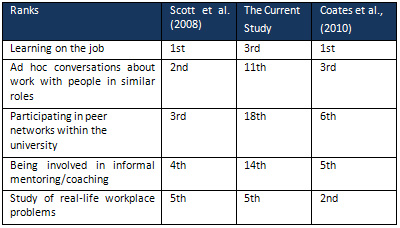
Although
ad
hoc
conversations
about
work
with
people
in
similar
roles,
participation
in
peer
networks
within
the
university
and
involvement
in
informal
mentoring/coaching
were
not
within
the
first
five
ranks
of
preferred
approaches
at
COM-J,
the
results
still
indicate
the
need
for
this
program,
as
the
environment
is
currently
not
supporting
such
approaches.
Establishing
a
competency-based
model
for
the
ALD
program
at
COM-J
will
follow
Kern's
six-step
approach:
problem
identification,
general
needs
assessment,
targeted
needs
assessment,
goals
and
objectives,
program
strategies,
implementation
and
evaluation.
This
study
constitutes
the
general
needs
assessment
step
of
the
project.
1.
We
limited
the
definition
of
academic
roles
to
those
who
are
positioned
as
formal
leaders,
but
there
are
likely
to
be
others
who
are
engaged
in
informal
leadership
positions.
Although
this
definition
is
behind
the
scope
of
this
study,
there
would
be
value
in
further
work
to
review
the
nature
and
effects
of
informal
leadership
at
COM-J.
2.
This
study
for
the
contextualization
of
the
model
to
COM-J
employed
a
quantitative
approach;
thus,
qualitative
studies
are
needed.
The
study
conducted
within
this
project
indicates
that
effective
performance
as
an
academic
leader
at
COM-J,
requires
the
combination
of
emotional
intelligence
(both
personal
and
interpersonal),
cognitive
capabilities
and
a
particular
set
of
relevant
skills
and
knowledge.
This
result
serves
to
confirm
the
conceptual
model
summarized
in
Figure
2.
The
results
are
also
consistent
with
those
of
parallel
studies
that
have
used
the
same
framework
(10).
1.
The
ALD
program
should
be
aligned
with
the
findings
of
this
study
with
regard
to
what
and
how
academic
leaders
prefer
to
learn.
2.
Further
qualitative
studies
using
semi-structured
interview
or
focus
groups
for
the
same
population
with
Scott,
Coates
and
Anderson's
(10)
conceptual
model
for
higher
education
leadership
capability
as
a
guide
are
required
to
improve
our
understanding
and
to
gain
a
rich
picture
of
leadership
at
COM-J.
3.
The
final
capability/competency
model
resulting
from
further
qualitative
studies
can
be
integrated
with
other
human
resource
practices
to
create
the
following:
i.
Hiring
guidelines
ii.
Job
descriptions
iii.
Promotion
criteria
iv.
Performance
appraisal
1)
Day
D.
V.,
&
Harrison,
M.
M.
A
multilevel,
identity-based
approach
to
leadership
development.
Human
Resource
Management
Review,
17(4),
360-373.2007
2)
Ramsden,
P.,
Prosser,
M.,
Trigwell,
K.,
&
Martin,
E.
University
teachers'
experiences
of
academic
leadership
and
their
approaches
to
teaching.
Learning
and
Instruction,
17(2),
140-
155.
2007
3)
Academic
leadership
center.
Ministry
of
Higher
Education,
Saudi
Arabia.
Retrieved
from
http://
http://www.alc.edu.sa.
2013
4)
Middlehurst,
R.,
Goreham,
H.,
&
Woodfield,
S.
Why
Research
Leadership
in
Higher
Education?
Exploring
Contributions
from
the
UK's
Leadership
Foundation
for
Higher
Education.
Leadership,
5(3),
311-329
.
2009
5)
Bryman,
A.
Effective
Leadership
In
Higher
Education.
London:
Leadership
Foundation
for
Higher
Education.
2009
6)
Bolden,
R.,
Petrov,
G.,
&
Gosling,
J.
Distributed
Leadership
in
Higher
Education:
Rhetoric
and
Reality.
Educational
Management
Administration
Leadership,
37(2),
257-277.
2009
7)
Gmelch,
W.
H.
The
department
chair's
balancing
acts.
New
Directions
for
Higher
Education
126,
16.2004
8)
Thi
Lan
Huong
Nguyen
(2012):
Identifying
the
training
needs
of
Heads
of
Department
in
a
newly
established
university
in
Vietnam,
Journal
of
Higher
Education
Policy
and
Management,
34:3,
309-321
9)
Spendlove,
M.
(2007),
Competencies
for
effective
leadership
in
higher
education.
International
Journal
of
Educational
Management,
21(5),
407-417
10)
Scott,
G.,
Coates,
H.,
&
Anderson,
M.
(2008).
Learning
leaders
in
times
of
change:
Academic
leadership
capabilities
for
Australian
higher
education.
11)
Goleman,
D.
(1999).
Working
with
Emotional
Intelligence.
Bloomsbury
Publishing.
12)
Coates,
Hamish
Bennett;
Meek,
V
Lynn;
Brown,
Justin;
Friedman,
Tim;
Noonan,
Peter;
and
Mitchell,
John,
"VET
Leadership
for
the
Future:
contexts,
characteristics
and
capabilities"
(2010).
http://research.acer.edu.au/higher_education/13
13)
Anderson
&
Johnson,
(2006),
Ideas
of
leadership
underpinning
proposals
to
the
Carrick
Institute:
A
review
of
proposals
from
the
'Leadership
for
Excellence
in
Teaching
and
Learning
Program'
|

